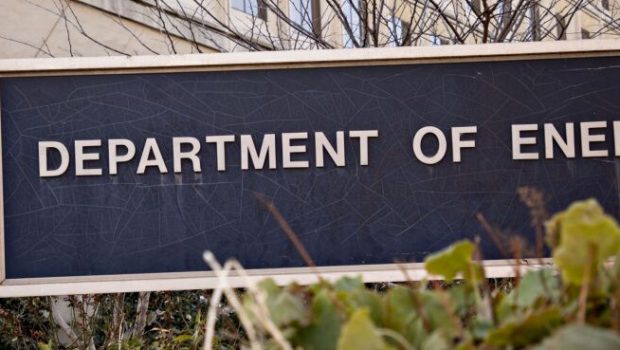Solyndra’s Ghost Haunts DOE Push for Billions for Technology (1)
The Biden administration is advancing billions of dollars to scale up emerging energy technology it says is needed to meet mid-century climate goals while looking to avoid the risk of another Solyndra—a decade-old, high-profile political failure that clouded those efforts.
The Energy Department hopes to tap into a rare vein of bipartisan support for two technologies in particular—direct air capture and hydrogen production—while selecting regions across the country to demonstrate their viability, department officials said in interviews and public appearances.
The department’s strategy will be on display at a summit Wednesday to build excitement and win over skeptics of its $3.5 billion direct air capture hub program, among $12.1 billion in money for carbon management programs allocated by Congress.
Energy Secretary Jennifer Granholm will join a slew of agency heads, White House officials and industry leaders to hype technology to remove carbon from the atmosphere—all while setting expectations that some projects will inevitably fail and that is part of the plan.
“It’s been a trust-building exercise all around, and I think today we’re at a far more active pace than we were in March 2021,” Jigar Shah, director of the department’s loan office, told Bloomberg Law.
Bipartisan Engagement
The agency is drawing from past shortcomings to ensure funding opportunities are competitive and clear milestones are set for project developers to unlock more funding, said Noah Deich, deputy assistant secretary for carbon management. He joined the agency in April after seven years leading Carbon180, an atmospheric carbon removal advocacy group.
The office is trying to “engage that bipartisan coalition, which is geographically spread across the US and make sure these projects are ones that can really be that down payment,” said Deich.
Some of the administration’s efforts will focus on the department’s revamped Loan Programs Office, which last month issued its first clean energy loan guarantee in nearly a decade to a hydrogen hub project in Utah.
The loan office has more than $40 billion in loans and loan guarantees available to issue, working through a stack of 77 loan applications asking for a total of $79.5 billion as of June, according to the agency. The office has seen 63% of its exposure held by investment-grade borrowers, with a loss rate of 3% of funds disbursed, figures that continue to improve, according to its annual portfolio report.
“LPO intends to build on its track record of success by continuing to select diverse, promising clean energy projects that can’t access private debt markets due to their innovative nature,” Shah said. “Due to that nature, not all will succeed; but investing in projects that we believe can catalyze game-changing industries is what we need to deliver on President Biden’s climate goals.”
The office, established by the Energy Policy Act of 2005, was “the first of its scale to really try to bridge the gap between R&D efforts and how we support commercial-scale projects,” said Nikesh Jindal, a partner with King and Spalding LLP who helped to set up the loan program as senior counsel in the Energy Department.
Black Eye
But the office got a black eye under the Obama administration when Solyndra, a solar company, filed for bankruptcy two years after receiving $535 million in federal loans. After 2012 Republican presidential nominee Mitt Romney and others repeatedly criticized the administration, the Energy Department blamed Solyndra’s business practices and departmental oversight of the loans.
Last November, Sen. John Barrasso (R-Wyo.) introduced the Energy Accountability Act (S. 3152) to “protect taxpayers from green energy boondoggles” by blocking borrowers that have previously defaulted on an Energy Department loan from applying for another one.
The bill followed a report from Barrasso’s office called “The Solyndra Syndrome and the Green Stimulus Delusion,” which examined the “striking parallels between the failed green energy stimulus policies of the Obama administration and the policy priorities of the Biden administration.”
Barrasso “continues to have concerns about waste of taxpayer money, including in programs such as the Department of Energy’s Loan Programs Office,” spokeswoman Sarah N. Durdaller said. “He believes we need to do more to ensure taxpayer money is spent on worthwhile projects rather than wasted on politically-connected ones.”
But Barrasso has pushed for carbon capture funding and supports hydrogen research, as Wyoming is a major producer of coal and oil and gas.
The department has made it clear the regional hubs will seek to lower risk by funding different baskets of technology, said Sasha Mackler, who directs the energy program at the Bipartisan Policy Center.
“The hub approach will be a very powerful one because it brings in more stakeholders, it helps achieve scale more quickly, you can share costs of shared infrastructure in ways that I think can bring forward more technologies,” Mackler said.
‘Establish Bankability’
After the Trump administration effectively closed the door to loans, Biden officials have been working to rebuild confidence in a “LPO 2.0,” Shah said. The clean energy entrepreneur and podcast host has been on a media blitz and forged relationships with the private sector and across the administration to process loans effectively.
The goal is to “establish bankability,” Shah said. A DOE loan, which backs the viability of the applicant’s emerging operation, can be copied by private banks across any given sector.
Officials are preparing for more front-end planning with communities and “enhanced oversight” of ventures that receive funding, said Kelly Cummins, acting director and principal deputy director for the Office of Clean Energy Demonstrations.
The office is a new effort by the department to scale up large-scale demonstration projects, with $20 billion to support a range of energy technologies, including $8 billion for hydrogen hubs.
“I think it’s not a surprise to folks in this room that the department has had a mixed bag of success when it comes to these demonstration projects,” Cummins said at an inaugural gathering of direct air capture advocates hosted by the Bipartisan Policy Center in Washington last month.








Gloss